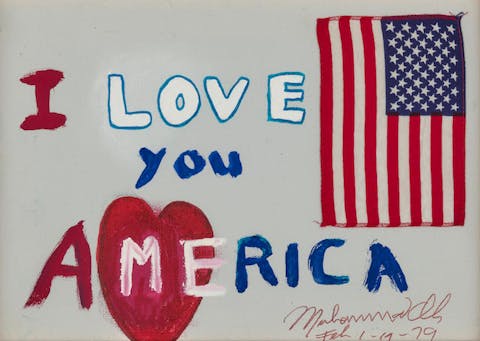Learn more about Muhammad Ali - a Renaissance man of the 20th Century
Muhammad Ali is best known for his amazing boxing career and is often related to as the greatest athlete of all time. But he truly was a Renaissance man of the 20th century, using his fame to make a mark in other important social areas, such as philanthropy and civil rights fight. He also was artistically talented, expressing himself in poetry, rap, acting and even painting.
Muhammad Ali attending a Saviours' Day celebration in 1974, source: Wikipedia
Becoming “The Great”
Muhammad Ali was actually born as Cassius Clay January 17, 1942 in Louisville, Kentucky in USA. He began training amateur boxing as a 12 year old, early proving his talent for this sport. Already at the age of 18, in 1960 he won his first Olympic Gold in the light heavyweight division and got his professional license later that year.

Muhammad Ali at the 1960 Olympics in Rome, source Wikipedia

On-site poster for Cassius Clay's fifth professional bout, source: Wikipedia
Ali’s professional career spanned for 21 years. During this time he had 61 fights of which he won 56. He won by KO (knockout) 37 times. Some of Ali’s fights are thought to be legendary to this day, including his toughest opponents George Foreman and Joe Frazer. Ali admitted that Foreman, who is famous for the hardest punches in heavyweight history, was the most challenging opponent he fought. Their bout called “Rumble in the Jungle” from 1974 gave Ali historic win over a heavyweight champion. But the most iconic and regarded by many as the best boxing fight of all time was the so-called “Thrilla in Manila” from 1975, where Ali scored a victory over Joe Frazer, his long time rival.

Muhammad Ali's boxing gloves preserved in the Smithsonian Institution, National Museum of American History, source: Wikipedia
Transition
Muhammad Ali became interested in Islam already in the late 1950’s when he first met the members of the Nation of Islam, a religious and political organisation focused on the African diaspora. He wanted to join already in 1962 but got rejected due to his boxing career and the violent nature of this discipline. It was not until two years later, and short after he became a champion after the fight with Liston that the organisation admitted his membership and received his new name: Muhammad (one who is worthy if praise) Ali (most high). Ali was glad to be freed from his previous name, who he referred to as a “slave name”, since the person he was named after was a white man who owned slaves ( he only released them after he 13th Amendment to the Constitution finally forbade its practice).

Muhammad Ali at on of the NOI's meetings, 1964, source: Wikipedia
Activist and Philanthropist
People from the closest circle regarded Ali as the most kind hearted person, always ready to help those in need. He was a pacifist and refused to fight in Vietnam, which almost ended his career. After transition to Islam he was devoted to practicing Islamic duty of charity and good deeds, by donating million of dollars to charity organisations and people discriminated for their various religious beliefs. He supported the world fight with hunger and was involved in the youth education, supporting young Afro-Americans in colleges, giving inspirational speeches and donating for the programs to develop. He was also supporting the rights of Native Americans, walking in one row in The Longest Walk, with Steve Wonder and Marlon Brando. Throughout his life Ali always stood on the side of the poor, discriminated against and oppressed.
"Throughout his life Ali always stood on the side of the poor, discriminated against and oppressed."
Artistic Talents
Muhammad Ali was a man of many talents. Apart of his boxing career proved him self several times as a fine actor, starring in several movies, including documentaries, autobiographical pictures and a historical drama called “Freedom Road” from 1978.
Despite his dyslexia, Ali had a great talent to produce spoken word poetry. He often used rhymes for his trash talking in boxing and for his activist involvement where he created political poetry. Many see his rhyme schemes had a role in shaping black poetic tradition as well as were an important ingredient in emergence and evolution of the rap music in 1970. According to The Guardian, "Some have argued that" Ali was "the first rapper.
Not many people knew that Ali also expressed himself as an artist and loved drawing and painting. Most of his works were created in the 1970’s. In 1977 a gallerist Rodney Hilton Brown sold his paintings in his New York Gallery. Brown also authored a book on Ali’s artistic career titled “Muhammad Ali: The Untold Story: Painter, Poet and Prophet”.
On October 5th, 2021, a series of Ali’s drawings from Brown’s collection was sold at Bohnams New York for a record prize of $1 000 000. Among them were works like “Sting Like a Bee” (1978), an image of Ali’s boxing-ring victory sold to a collector for $425,000 and a 1979 painting on canvas reading “I Love You America” sold for $150,000. You can check all the other lots from this auction here.

Muhammad Ali, Sting Like a Bee” (1978), source: Bohnams

Muhammad Ali, “I Love You America” (1979), source: Bohnams

